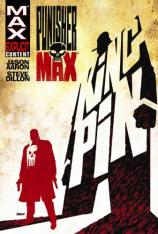PunisherMax: Kingpin
Review
PunisherMax: Kingpin
Jason Aaron writes the blood-soaked pages of Punisher Max with a pitch-black sense of humor that recalls Garth Ennis’s earlier work with Frank Castle, aka The Punisher. In fact, it’s hard not to draw comparisons between these two comic writers. Ennis, joined with his Preacher artist Dillon, redefined The Punisher in 2000 with his work on the maxiseries “Welcome Back, Frank,” before spinning it off into a new Punisher comic series, both of which were published under the Marvel Knights banner. Growing tired of the increasingly comedic slant and wanting to do a more serious, hardcore take on the character, Ennis relaunched the series under Marvel’s adults-only Max label. Through it all, he combined crime tales of drug lords and mafia dons and human slavers, colored at times with dark satire. When he departed the title after issue 60, Ennis had been the definitive voice of The Punisher for nearly a decade.
Aaron’s inaugural run on the series, still under the adult-oriented Max imprint, isn’t as serious and gritty as Ennis’s later work, but he manages to create an interesting blend of two different takes on the Marvel antihero. Aaron is allowed to work unfettered, producing content for a mature readership—something that is made quite clear in the opening pages with brutally loving attention to violence and torture. The crime saga is tinged with frat-house humor that recalls Ennis’s earlier work under the Marvel Knights banner as readers are treated with shocking, dark, at times disturbing, moments of humor. One sequence involving an elderly mafia don’s widow is both humorous and indelibly brain-scarring.
In Punisher Max: Kingpin, Frank Castle is continuing his killing spree against members of organized crime after having thinned out several of New York’s biggest crime families. Aaron understands Castle’s motivations as well as Ennis did, knowing that Frank is a killer, plain and simple. It’s his core mission, an integral part of his psyche. Even gravely wounded, the Punisher knows he has to survive so that he can keep on killing. The story that drives his homicidal need under Aaron’s direction involves a new council of family dons looking for a plan to take the heat away from them while they figure out how to kill Castle. They turn to Wilson Fisk for the answer.
Fisk plans on creating a fictitious Kingpin, a rich crime lord who oversees and unites all of the crime families. Using the mafia’s money and buying off rival gangs and drug cartels, Fisk spreads the Kingpin rumor and soon the Punisher is chasing after a ghost. Fisk, meanwhile, has plans of his own and intends on becoming the Kingpin through a series of simple and intelligent double-crosses. Thanks to Ennis, the Punisher has been well-established for quite some time, so Aaron’s opening volley in this new series actually serves as an origin story for the central villain.
Steve Dillon returns to the pencils and his style evokes the earlier over-the-top mayhem art of his earlier run on the Marvel Knights series. Having been absent from a Punisher title for a while, Dillon is now given free run under the Max imprint and lets loose creating panels of shocking humor and gory violence that recall the glory days of Preacher. His cleanly detailed art style works well here, as it did on “Welcome Back, Frank,” and his return to the world of Frank Castle is comfortably familiar and welcome.
Despite a small misstep with the late introduction of a hired-gun called The Mennonite, Aaron largely succeeds with his interpretation of The Punisher. Given the world-building he is doing with introducing and recreating The Kingpin, a well-established character in the normal Marvel Universe, The Mennonite seems almost like a too-silly throwback to the villains Ennis grew sick of creating for Castle to kill under the Marvel Knights banner. Because Kingpin is clearly intended to be the series villain for the duration of Aaron’s run, he is not somebody that can be quickly dispensed with. This puts Aaron in a corner, as he needs a tough figure to challenge Castle during the book’s climax but is unable to use the title villain while Fisk carries out his own plans. Ultimately, the execution strikes a discordant note within the context of the surrounding story and The Mennonite seems misplaced.
That said, Aaron does still manage to strike a powerful note on the theme of family and the lengths these trio of characters go to in defending and defining the value of their families through their actions. The murder of Frank Castle’s family has long been the excuse he needed in order to kill, to become the Punisher, and Aaron presents a truly interesting juxtaposition of this scenario as Wilson Fisk rises to power to become the Kingpin.
With Punisher Max: Kingpin, Aaron proves to be a worthy successor to Ennis. Although there are a few kinks that need to be worked out while he learns to balance dark satire with gritty violence, it proves to be an entertaining and worthwhile read and a wonderful origin story for a new villain. Ennis left large shoes to fill, but Aaron seems to be more than up for the challenge.
Reviewed by Michael Hicks on July 13, 2012
PunisherMax: Kingpin
- Publication Date: June 30, 2010
- Genres: Graphic Novel
- Hardcover: 120 pages
- Publisher: Marvel
- ISBN-10: 0785145966
- ISBN-13: 9780785145967




